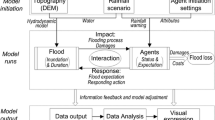Abstract
A computerized simulation model for capturing human behavior during flood emergency evacuation is developed using a system dynamics approach. It simulates the acceptance of evacuation orders by the residents of the area under threat; number of families in the process of evacuation; and time required for all evacuees to reach safety. The model is conceptualized around the flooding conditions (physical and management) and the main set of social and mental factors that determine human behavior before and during the flood evacuation. The number of families under the flood threat, population in the process of evacuation, inundation of refuge routes, flood conditions (precipitation, river elevation, etc.), and different flood warnings and evacuation orders related variables are among the large set of variables included in the model. They are linked to the concern that leads to the danger recognition, which triggers evacuation decisions that determine the number of people being evacuated. The main purpose of the model is to assess the effectiveness of different flood emergency management procedures. Each procedure consists of the choice of flood warning method, warning consistency, timing of evacuation order, coherence of the community, upstream flooding conditions, and set of weights assigned to different warning distribution methods. Model use and effectiveness are tested through the evaluation of the effectiveness of different flood evacuation emergency options in the Red River Basin, Canada.
Similar content being viewed by others
References
Ahmad, S. and Simonovic, S. P.: 2001, Modeling human behavior for evacuation planning: A system dynamics approach, in Bridging the Gap, In: Don Phelps and Gerald Shelke (eds), Proceedings of the ASCE World Water and Environmental Resources Congress, Orlando, May, pp. 14.
J. W. Forrester (1961) Industrial Dynamics Productivity Press Portland, Oregon
Hannigan, J. A. and Kueneman, R.: 1978, Anticipating flood emergencies: A case study of a Canadian disaster subculture, In: Disasters: Theory and Research, Sage, Beverly Hills/London.
R. O. Hansson D. Noulles S. Bellovich (1982) ArticleTitleKnowledge, warning, and stress: A study of comparative roles in an urban floodplain Environ. Behav 14 IssueID2 171–185
InstitutionalAuthorNameHigh Performance Systems Inc. (1992) Tutorial and Technical Documentation STELLA® II Hanover NH
Hori, T.: 1999, Micro model simulation of flood refuge actions, Research Report, Department of Civil Engineering Systems, Kyoto University.
Hori, T. and Takasao, T.: 1997, Drought control under the Interaction between the uncertainty of inflow predictions and the fuzziness of decision criteria. International Conference on Large Scale Water Resources Development in Developing Countries: New Dimensions of Prospects and Problems, Katmandu, Nepal, October 20--23.
Hori, T., Shiba, M., and Takasao, T.: 1999, An object-oriented evaluation model of local flood disaster preparedness. Proceedings of Water 99 Joint Congress, Brisbane, Australia, 6--8 July.
IJC (International Joint Commission) 2000, The next flood: Getting prepared, Final Report of the Red River Basin Task Force, Ottawa, Washington, pp. 164.
S. B. Laska (1990) ArticleTitleHomeowner adaptation to flooding: An application of the general hazards coping theory Environ. Behav 22 IssueID3 320–357
M. Morris-Oswald S. P. Simonovic (1997) Assessment of the social impact of flooding for use in flood management in the Red River Basin, Report Prepared for the International Joint Commission University of Manitoba Winnipeg 73
E. L. Quarantelli D. Russell (1977) ArticleTitleResponse to social crisis and disaster Annu. Rev. Sociol 3 23–49
J. K. Riad F. H. Norris (1996) ArticleTitleThe influence of relocation on the environmental social, and psychological stress experienced by disaster victims, Environ. Behav 28 IssueID2 163–182
InstitutionalAuthorNameScience Applications International Corp (1999) Information/data Needs for Floodplain Management: The Red River Basin Workshop McLean Virginia 39
S. P. Simonovic (1999) ArticleTitleSocial criteria for evaluation of flood management decisions: Winnipeg case study Urban Water 1 IssueID2 167–175
J. D. Sterman (2000) Business Dynamics: Systems Thinking and Modeling for a Complex World McGraw Hill NY
T. Takasao M. Shiba T. Hori (1995) ArticleTitleModeling of inhabitants’ attitude on flood disasters for flood refuge simulation J. Hydrosci. Hydraulic Eng 71–79 IssueID1 71–79
G. A. Tobin J. C. Ollenburger (1996) ArticleTitlePredicting levels of postdisaster stress in adults following the 1993 floods in the upper midwest Environ. Behav 28 IssueID3 340–357
Author information
Authors and Affiliations
Corresponding author
Rights and permissions
About this article
Cite this article
Simonovic, S.P., Ahmad, S. Computer-based Model for Flood Evacuation Emergency Planning. Nat Hazards 34, 25–51 (2005). https://doi.org/10.1007/s11069-004-0785-x
Received:
Accepted:
Issue Date:
DOI: https://doi.org/10.1007/s11069-004-0785-x




